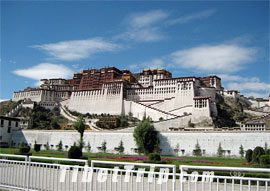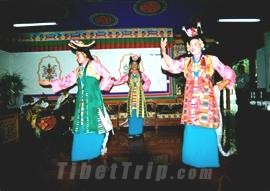Whether you want to travel in Tibet by joining a group tour package, or you just would like to learn something about this mysterious region, you can get some useful information from the following words.
 Introduction
Introduction
Tibet (Xizang), known as the 'Roof of the World', has become a dream destination for climbers, adventurers and regular tourists from all over the world. Visitors are guaranteed to enjoy the enthralling year-round snow, aerial mountains, mysterious religions, exotic customs and spectacular inhabitants.

 Climate
Climate
Located at an average altitude of over 4000 m. (13,123 ft.), Tibet has a cold and dry plateau climate in most areas, with the exception of some regions in the south and east. The peculiar landscape and climate have gestated immense natural resources in this expansive land.
 Geography
Geography
The physiognomy is very complicated and varied. In the north lies a high plateau surrounded by the serial mountain ranges of Mt. Nyainqentanglha, Karakoram Mountains and Gangdise, while the huge Himalayas range extends through the south. In the east lies another smaller continuous mountain range, Mt. Hengduan. Various landscapes composed of basins, plains, canyons, valleys, lakes, rivers and glaciers form in the low areas. Many large rivers originated here, such as China's Yangtze, Yellow River, Yarlung Tsangpo River (Brahmaputra), Jinsha River, Nu River (Salween) and Lancang River (Mekong) and India's Indus and Ganges. Over 1500 lakes are sprinkled over Tibet, of which most are located on the northern plateau, making it the area in China with the highest lake density and earning it the reputation of being the 'Hometown of Lakes'. The Karuola Glacier is also a natural wonder that has conquered the hearts of many tourists.
 Transportation
Transportation
Transportation condition in Tibet has changed greatly since 1951 when pack animals were the main transportation in the region. Now railway, highways and airlines are connecting it with other regions of China.
 History
History
Tibet has a recorded history of about 1,300 years, but its original inhabitants appeared as early as in the Paleolithic Age. There are 7 administrative regions, namely Lhasa, Shigatse, Shannan, Nyingchi, Chamdo, Nakchu and Ngrai. Traditionally the regions centered at Lhasa is called Usang (Front Tibet) and those at Shigatse is called Tsang (Rear Tibet), which are respectively managed by Dalai Lama and Panchen Lama.
 Natural Resources
Natural Resources
Tibet is the kingdom of plants and is home to complete virgin forests of spruces, firs, pines, cypresses and valuable herbs of snowdrops, fritillaries, tuckahoes and muskiness. It is also the paradisical habitat of thousands of rare wild animals, such as lesser pandas, antelopes, yaks, black-neck cranes, white-lipped deer, etc. It is also abundant in resources such as minerals, terrestrial heat, water energy, wind energy and solar energy. Yangpachen is the first research base for terrestrial heat energy in China.

 Tibetan People
Tibetan People
The Tibetans are very unique and versatile people. Most of them believe in Tibetan Buddhism and worship and circumambulate around temples, shrines and other holy places. Based on their beliefs and knowledge, they have created brilliant arts and crafts like Thangka, murals, sculptures, knives, Carpets, costumes, their own opera, calendar, medicine, language and other unique local cultures and customs. The Barkhor Street in Lhasa is a bazaar to sell all kinds of these handicrafts. The finely dressed Tibetans are also extremely hospitable. They are eager to present Khatag, propose a toast by their festive chang and Yak Butter Tea and perform their adept singing and dancing to greet the guests, making it a really enjoyable experience to approach them.








